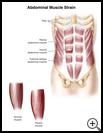
Abdominal Muscle Strain
________________________________________________________________________
KEY POINTS
- An abdominal muscle strain is a stretch or tear of a muscle in your child’s belly. A strain may also be called a "pulled" muscle.
- Your child’s healthcare provider may recommend stretching and strengthening exercises and other types of physical therapy to help your child.
- Ask your child’s provider how to take care of your child at home what symptoms or problems you should watch for and what to do if your child has them.
________________________________________________________________________
What is an abdominal muscle strain?
An abdominal muscle strain is a stretch or tear of a muscle in your child’s belly. A strain may also be called a "pulled" muscle.
What is the cause?
Your child may strain muscles during an activity like lifting, twisting, or even hard coughing or sneezing. Muscles can also get strained from overuse, such as doing lots of sit-ups or crunches.
What are the symptoms?
Your child may have soreness or pain in one area of his belly, near the area of the pulled muscle. He may have more pain when he moves, coughs, or sneezes.
How is it diagnosed?
Your healthcare provider will ask about your child’s symptoms, medical history, and activities, and examine your child. Your provider may ask your child to move or exercise, to see if it causes pain. Your child may have tests to look for other causes of the pain.
How is it treated?
Your child will need to change or stop doing the activities that cause pain until his muscles have healed.
Your child’s healthcare provider may recommend stretching and strengthening exercises and other types of physical therapy to help your child.
A mild strain may heal within a few weeks. A more severe strain may take 6 weeks or longer.
How can I take care of my child?
Follow the full course of treatment prescribed by your healthcare provider. In addition:
- Give your child nonprescription medicine, such as acetaminophen, ibuprofen, or naproxen to treat pain. Read the label carefully and give your child the correct dose as directed.
- Nonsteroidal anti-inflammatory medicines (NSAIDs), such as ibuprofen, naproxen, and aspirin, may cause stomach bleeding and other problems.
- Check with your healthcare provider before you give any medicine that contains aspirin or salicylates to a child or teen. This includes medicines like baby aspirin, some cold medicines, and Pepto-Bismol. Children and teens who take aspirin are at risk for a serious illness called Reye’s syndrome.
- Acetaminophen may cause liver damage or other problems. Do not give more doses than directed. To make sure you don’t give your child too much, check other medicines your child takes to see if they also contain acetaminophen. Unless recommended by your healthcare provider, your child should not take this medicine for more than 5 days.
- Put an ice pack, gel pack, or package of frozen vegetables wrapped in a cloth on the sore area every 3 to 4 hours for up to 20 minutes at a time.
- Moist heat may help relax your child’s muscles, but do not use heat if your child has any swelling in the area. Put moist heat on the sore area for 10 to 15 minutes to help relieve soreness or before your child does warm-up and stretching exercises. Moist heat includes a warm bath or shower or a warm wet washcloth or towel.
- Do not leave your child alone while the cold or warm pack is in place. Check the area under the pack for skin irritation every 5 to 10 minutes. If you see signs of skin irritation such as color changes (dark red, purplish red or white) or blisters, remove the pack and call your child’s healthcare provider.
Ask your child’s provider:
- How and when you will get your child’s test results
- How long it will take to recover
- If there are activities your child should avoid and when he can return to normal activities
- How to take care of your child at home
- What symptoms or problems you should watch for and what to do if your child has them
Make sure you know when your child should come back for a checkup. Keep all appointments for provider visits or tests.
How can I help my child prevent abdominal muscle strains?
Teach your child to do warm-up exercises and stretches before activities to help prevent injuries. Strong, flexible muscles are less likely to be strained. Follow your child’s healthcare provider’s advice about how your child can strengthen abdominal muscles, such as by doing sit-ups or abdominal crunches.
It’s better if your child plays a lot of different sports. This helps prevent overuse of any one muscle group. Make sure that your child does not overdo it when starting an exercise program or when playing sports.
When your child lifts heavy objects, teach him to bend his knees and hips and keep his back straight.
Last modified: 2016-05-17
Last reviewed: 2016-08-02

